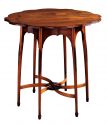Career Profile: Furniture Finisher (French version available)

Every room in your home or school likely has furniture in it. The tradespeople who make this furniture look and feel good are furniture finishers. As the name shows, these people work at the end of the process of making furniture. If you have abilities in design, skills in working with your hands, and an interest in helping to keep furniture comfortable and safe, the job of furniture finisher might be right for you.
Furniture finishers generally work in factories, retail stores, or repair shops. Some furniture finishers are self-employed, but others work for large companies. In factories, they normally work with new furniture, applying stains and varnishes to wood or paint to metal. Elsewhere, they might work with either new or used furniture, anything from a small stool to a large dining room table to the frame of a sofa. Sometimes, older furniture might be fragile, and furniture finishers need to be especially careful to avoid breaking anything.
Except in factories, furniture finishers work mainly with older furniture that people want to renew so that it looks better. Sometimes, furniture finishers might need to file or sand down rough areas on chairs or tables so that the people using the furniture will not get splinters in their hands or cut themselves on rough edges. In large factories, they might work on only a small part of the process, but in smaller companies, they might also do other jobs such as assembling the furniture or working with sales. Being able to work with others and to deal well with the public is important for many people in this job.
Generally, furniture finishers need a high school diploma or the equivalent to work in their business. Mathematics and English courses are helpful. Some additional training at a trade school can be helpful, but most people learn on the job. Having a good sense of colour and style is useful for being able to match wood stain with the colour of the upholstery or the shade of metal with the rest of the piece of furniture. Skills in mathematics can help with calculating the amounts of necessary supplies or for bookkeeping if necessary, and a fairly high reading level can help workers understand written instructions on paint cans and other supplies.
Working as a furniture finisher is not a very dangerous job, although small injuries such as cuts and sprained wrists are some of the main hazards. The fumes from paints and stains can also be harmful, and furniture finishers might need to wear special masks to avoid harming their lungs. The days can be long if a job is in progress, especially since stains and paints look better if they dry evenly. Wages for furniture finishers start at about $15.00 per hour and can rise to $27.00 per hour with experience, or between $31,000 and $56,000 per year.
Finishing furniture is the kind of work that people can do for many years if they want. Reasonably good vision and a basic level of strength are important, and people in this field should be able to bend and stretch without too much trouble. However, the work can become too difficult for older workers, and they might want to move to an office-based aspect of the job as they age. If this trade appeals to you, working as a furniture finisher can be a good career choice.
Bibliography:
Career One Stop. “Furniture Finishers.” https://www.careeronestop.org/toolkit/careers/occupations/occupation-profile.aspx?keyword=Furniture%20Finishers&onetcode=51702100&location=Maine.
Job Bank. “Furniture Finishing in Canada.” https://www.jobbank.gc.ca/marketreport/summary-occupation/12759/ca.
Payscale Canada. “Furniture Finisher: Hourly Rate.” https://www.payscale.com/research/CA/Job=Furniture_Finisher/Hourly_Rate.
Work BC. “Furniture Finishers and Refinishers (NOC 9534).” https://www.workbc.ca/careers/9534.





Leave a comment!